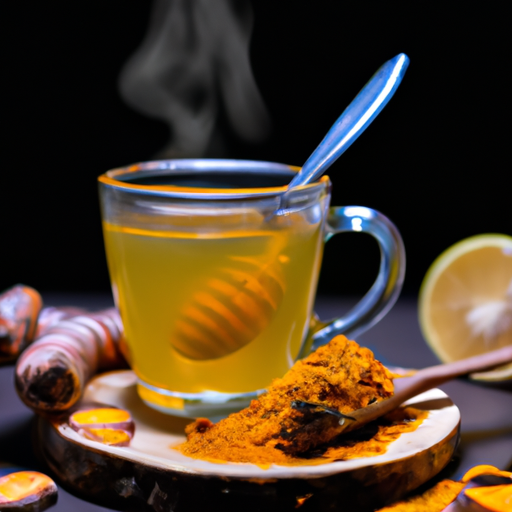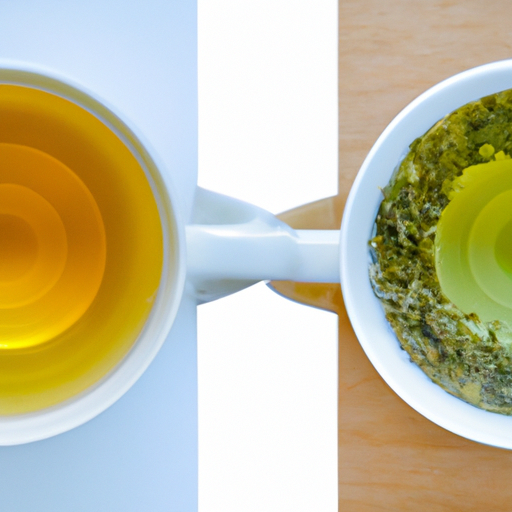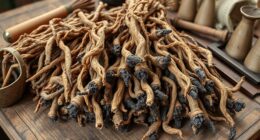Turmeric is akin to a burst of sunlight in a mug. Its radiant hue brings to mind warmth and coziness, while its incredible health advantages are truly remarkable. Whether you seek a natural method to enhance your immune system, alleviate inflammation, or simply relax after a hectic day, turmeric tea could be precisely what you need.
Making your own turmeric tea is surprisingly easy and incredibly satisfying. Not only will you save money by skipping the store-bought varieties, but you’ll also have complete control over the ingredients and flavor profile.
So grab your favorite mug and let’s get started on this delightful journey towards better health and relaxation!
Key Takeaways
- Turmeric tea can boost the immune system, reduce inflammation, and alleviate symptoms of arthritis, heart disease, and cancer.
- Turmeric tea can be made using either turmeric powder or fresh turmeric root, with boiling water, and optional honey or lemon.
- Turmeric can also be used in cooking as a spice rub or added to soups and stews.
- Additional ingredients such as cinnamon, milk or cream, honey, and coconut water can enhance the taste and nutritional value of turmeric tea.
Overview of Turmeric and its Benefits
You’ll be amazed at how turmeric can transform your health – it’s packed with benefits that you won’t want to miss out on! Turmeric is a root that has been used for centuries in traditional medicine and cooking.
It contains a powerful antioxidant and anti-inflammatory compound called curcumin, which has been shown to have numerous health benefits. Studies have shown that turmeric supplements can help reduce inflammation in the body, which may help alleviate symptoms of conditions such as arthritis, heart disease, and even some types of cancer.
Additionally, incorporating turmeric into your cooking may also provide these benefits. So whether you choose to take a supplement or use turmeric in your recipes, this versatile spice is definitely worth adding to your routine.
Now let’s gather our ingredients and get started!
Gather Ingredients
Seriously, you don’t have any of these basic ingredients in your pantry already? Making turmeric tea doesn’t require a lot, but there are certain things you need to have on hand in order to do it right. Here’s what you’ll need:
- Turmeric powder or fresh turmeric root
- Water
- Honey or lemon (optional)
Turmeric is the star of this show, so make sure you have it on hand. If you’re unable to get your hands on turmeric powder or fresh turmeric root, there are other ingredient alternatives that can be used instead. Ginger is one popular substitute for turmeric and has similar health benefits such as reducing inflammation and aiding digestion.
Now that we have our ingredients ready, let’s move onto preparing the turmeric.
Prepare the Turmeric
So, now that I’ve got all the ingredients, it’s time to move on to preparing the turmeric.
First things first, I’ll need to peel and chop the root before using it in my recipe. Alternatively, I can also use powdered turmeric if that’s more convenient for me.
Either way, let’s get started on this important step to make sure our turmeric tea is as tasty and beneficial as possible!
Peeling and Chopping
First, grab a vegetable peeler to easily remove the skin from the turmeric root before slicing it into small pieces. This step is important not only for achieving a smoother texture but also for ensuring that your tea doesn’t have any unwanted dirt or impurities.
Here are some tips I’ve learned when peeling and chopping turmeric:
- Be careful when using a knife as turmeric can stain your hands and clothes.
- If you don’t have a peeler, you can use a spoon to scrape off the skin.
- To make chopping easier, try freezing the turmeric root for 15 minutes beforehand.
Now that your turmeric is peeled and chopped, let’s move on to the next step of making our delicious tea using powdered turmeric.
Using Powdered Turmeric
Now that we have our golden treasure, let’s explore how to unlock its full potential with some powdered turmeric. Using powdered turmeric is an easy and convenient way to make a cup of warm and comforting turmeric tea. Not only does it provide the same health benefits as fresh turmeric root, but it also saves time and effort in the preparation process.
To help you better understand the benefits of using powdered turmeric, here is a table comparing the nutritional values of fresh vs. powdered turmeric:
| Nutrient | Fresh Turmeric | Powdered Turmeric |
|---|---|---|
| Curcuminoids | 3-4% | 2-5% |
| Potassium | 170 mg | 208 mg |
| Iron | 1.7 mg | 1.8 mg |
| Vitamin C | Less than 1mg | .5mg |
| Fiber | .9g | .8g |
As you can see, using powdered turmeric provides similar amounts of important nutrients as fresh turmeric. Plus, it allows for more versatility in your use of the spice beyond just making tea! Consider trying out alternative recipes like adding a pinch to your morning smoothie or incorporating it into marinades for chicken or fish.
Now, let’s move on to boiling water for our tea.
Boil Water
To start making turmeric tea, you’ll need to grab a pot and fill it with water. Boiling water is an important step in making any kind of tea as it helps release the flavor and aroma of the herbs or spices used.
Different types of tea are made with boiled water such as black, green, white, oolong, and herbal teas. Each type requires different temperature and steeping time for optimal flavor.
For turmeric tea, we’ll need to bring the water to a boil first before adding the turmeric powder. It’s important not to add the turmeric when the water is cold as it won’t dissolve properly and may leave some chunks in your drink.
Once the water has reached boiling point, reduce heat to low and add one teaspoon of turmeric powder per cup of water. Let it simmer for about 10 minutes before turning off the heat.
Now we can move on to straining and sweetening our golden turmeric tea!
Add Turmeric and Simmer
So now that I’ve boiled my water, it’s time to add in the turmeric and let it simmer. The amount of turmeric you use is up to personal preference, but I usually measure out about half a teaspoon per cup of water.
As for simmering time, I find that 10-15 minutes is enough for the turmeric to infuse into the water and create a flavorful tea.
Measuring Turmeric
When measuring turmeric, it’s important to use a precise amount for the perfect balance of flavor. Turmeric measurement can make or break the taste of your tea, so it’s crucial to measure accurately.
Here are some tips on how to measure turmeric:
- Use a teaspoon or tablespoon: These common kitchen utensils are great for measuring spices like turmeric. A level teaspoon is equivalent to around 2 grams of ground turmeric.
- Make sure you’re using the right spoon: A tablespoon and a teaspoon may look similar, but they hold different amounts. Be sure to use the correct size when measuring.
- Level off the spoon: When measuring with a spoon, make sure to level off the top with a knife or your finger. This ensures that you’re getting an accurate measurement.
If you want an even more precise measurement, use a kitchen scale. Weighing out your turmeric will give you consistent results every time.
Now that we’ve covered how to measure your turmeric accurately, let’s move on to simmering time and how long you should let your tea brew before enjoying its warm flavors.
Simmering Time
You’ll want to let your mixture of spices and water come to a gentle boil, creating a fragrant atmosphere in your kitchen as the aromas waft through the air. Once it reaches this point, adjust the heat to low and allow it to simmer for about 10-15 minutes.
This is an important step because it gives time for all the flavors and nutrients from the turmeric, ginger, cinnamon, black pepper, and honey or lemon to infuse into the water. Simmering also helps release curcumin, which is the active ingredient in turmeric that has powerful anti-inflammatory effects.
The longer you simmer, the more potent your tea will be. However, be careful not to overdo it as boiling for too long can cause bitterness in taste. Once you’ve allowed it to simmer for at least 10 minutes or until desired potency is reached, you’re ready to strain the tea into a cup and enjoy its warm comforting goodness.
Strain the Tea
Next, grab a strainer and place it over your cup before pouring the turmeric tea through to remove any excess bits. There are several straining methods you can use, such as using a fine mesh sieve or cheesecloth. These methods will ensure that you have a smooth and silky texture for your tea.
Aside from giving your tea a better texture, straining also has health benefits. It removes any small particles that may cause irritation in your throat or digestive system. Turmeric contains curcumin, which is known for its anti-inflammatory properties, so drinking strained turmeric tea can help alleviate inflammation in your body.
Now that your tea is strained, it’s time to add sweetener and milk to taste.
Add Sweetener and Milk
To make your turmeric tea taste even better, add a sweetener like honey or maple syrup and some milk or cream for a creamy texture. Adding spices like cinnamon, ginger, or cardamom can also enhance the flavor of your turmeric tea. These spices not only add depth to the taste but also offer additional health benefits.
Turmeric itself is known for its anti-inflammatory and antioxidant properties, making it a great addition to any diet. Adding other spices such as cinnamon and ginger can help with digestion and blood sugar regulation. Milk or cream adds a creamy texture to the tea while providing calcium and vitamin D. Sweeteners like honey provide a natural source of sweetness while offering antibacterial properties that can improve gut health. By adding these ingredients to your turmeric tea, you not only elevate the taste but also maximize its potential health benefits. Now that we have added our sweeteners and milk let’s learn how to serve and enjoy our delicious turmeric tea!
Serve and Enjoy
Now that I’ve added sweetener and milk to my turmeric tea, it’s time to serve and enjoy. But before I take a sip, there are a few more things to consider.
First, choosing the right cup can enhance the experience of drinking tea.
Second, adding lemon or other flavors can add depth and complexity to the flavor profile.
Let’s discuss these key points further.
Choosing the Right Cup
Imagine sipping on a warm, soothing cup of turmeric tea from your favorite mug that perfectly complements the earthy and bold flavors of this golden elixir. Choosing the right cup for your tea can enhance your overall drinking experience and even offer health benefits. When it comes to turmeric tea, selecting the appropriate material for your cup is crucial in maintaining its unique flavor profile and reaping all of its potential health benefits.
Different materials can affect the taste, temperature, and aroma of your turmeric tea. For example, ceramic cups are known for their ability to retain heat well, while glass cups allow you to appreciate the color and texture of your beverage. Moreover, using cups made of specific materials such as stainless steel or copper may offer additional benefits like better heat retention or even antibacterial properties. By carefully considering which cup material to use when enjoying turmeric tea, you can optimize not only its taste but also its potential health effects. Now that we have chosen our perfect cup let’s add some lemon or other flavors!
Adding Lemon or Other Flavors
You’re ready to take your turmeric elixir up a notch by infusing it with zesty lemon or other tantalizing flavors. Not only does adding lemon enhance the taste of your tea, but it also boosts its nutritional value.
Lemon is an excellent source of Vitamin C and antioxidants that help strengthen the immune system and fight off free radicals in the body. It’s also known to aid digestion, promote hydration, and reduce inflammation.
Aside from lemon, there are plenty of other flavor variations you can experiment with when making turmeric tea. You can add ginger for an extra kick of spice or honey for a touch of sweetness. Some people even like to mix in cinnamon or cayenne pepper for additional health benefits and flavor complexity.
The possibilities are endless, so don’t be afraid to get creative with your ingredients! In the next section, I’ll share some tips and variations on how to make the perfect cup of turmeric tea.
Tips and Variations
I love making turmeric tea and experimenting with different ways to enjoy it. One of my favorite variations is iced turmeric tea, which is perfect for hot summer days.
I also like to add other spices such as ginger or cinnamon for added flavor and health benefits. Don’t forget the amazing health benefits that come with drinking turmeric tea, including reducing inflammation and boosting immunity.
Give it a try at home and see how you can make this delicious and nutritious drink a regular part of your routine!
Making Iced Turmeric Tea
To make iced turmeric tea, simply brew a strong batch of turmeric tea and pour it over ice. It’s a refreshing alternative to traditional hot turmeric tea, especially during the warmer months. Not only is this beverage delicious, but it also offers numerous health benefits.
Here are some ideas for making your iced turmeric tea even more enjoyable:
- Add a squeeze of lemon or lime juice for extra flavor and Vitamin C.
- Sweeten with honey or maple syrup instead of sugar for a healthier option.
- Garnish with fresh mint leaves or sliced ginger for added freshness.
- Use coconut water instead of regular water to enhance hydration and add electrolytes.
- Experiment with other spices like cinnamon or cardamom to create unique flavors.
Now that you know how to make refreshing iced turmeric tea and some tips on how to customize it, let’s move on to adding other spices for even more variety.
Adding Other Spices
Spice things up in your iced turmeric tea by adding other aromatic spices like nutmeg or cloves. Not only do these spices add a unique flavor profile to your tea, but they also come with their own health benefits.
Nutmeg has anti-inflammatory properties and can help improve digestion, while cloves are high in antioxidants and can aid in reducing inflammation. When experimenting with different spice combinations, consider the flavors that will complement the earthy taste of turmeric.
For example, cinnamon pairs well with turmeric and adds a sweet and spicy note to the tea. Ginger is another great addition as it has anti-inflammatory properties similar to turmeric and also helps soothe an upset stomach. Play around with different ratios of spices until you find the perfect combination for your taste buds.
By adding other spices to your iced turmeric tea, not only will you be enhancing its flavor but you’ll also be reaping more health benefits from this already powerful drink. Now let’s recap all of the amazing benefits that come from drinking turmeric tea.
Recap of Benefits
Just like a superhero that saves the day, turmeric tea comes with an arsenal of health benefits such as reducing inflammation and aiding in digestion, making it a perfect addition to your daily routine.
When it comes to turmeric, there are different varieties available in the market such as wild, Alleppey and Madras turmeric. Each variety has its unique flavor profile and color. I prefer using the wild variety because it has a more pungent taste and adds a beautiful golden hue to my tea.
Incorporating turmeric into meals is also another way to reap its benefits. Adding a pinch of turmeric powder to soups or stews enhances the flavor while providing numerous health benefits. Turmeric can also be used as a spice rub for meat or vegetables before grilling or roasting.
The possibilities are endless when it comes to incorporating this superfood into your diet! With all these amazing benefits in mind, why not give this delicious beverage a try? It’s easy to make and can be customized with your favorite spices and sweeteners for added flavor.
So go ahead, brew yourself a cup of warm turmeric tea today!
Encouragement to Try Turmeric Tea at Home
Why not give this delicious beverage a try and experience the numerous health benefits of turmeric tea from the comfort of your own home? Making turmeric tea is simple and easy. All you need is some water, grated or powdered turmeric, honey or lemon to taste, and a little patience.
Turmeric has long been known for its anti-inflammatory properties, making it an ideal ingredient in any healthy diet. Drinking turmeric tea regularly can help boost immunity, reduce inflammation, improve digestion, and even lower the risk of chronic diseases such as Alzheimer’s and cancer. So why not add this superfood to your daily routine by trying out new recipes that include turmeric?
You’ll be surprised at how easy it is to incorporate into your diet while reaping all the wonderful benefits!
Frequently Asked Questions
How much turmeric should I use for one cup of tea?
As an avid turmeric tea drinker, I’ve found that using 1 teaspoon of turmeric per cup of water is the perfect amount. Not only does it create a delicious flavor, but the benefits of turmeric tea are numerous, including reducing inflammation and boosting immunity. Check out some great recipes online for more variations!
Can I use ground turmeric instead of fresh turmeric root?
Using ground turmeric instead of fresh root has its pros and cons. Ground turmeric is easier to find, cheaper, and has a longer shelf life. However, fresh turmeric has more flavor and nutrients. Store turmeric in a cool, dry place for long term use.
How long should I simmer the turmeric tea for?
The optimal simmering duration for turmeric tea is 10-15 minutes at a temperature of 160-180°F. This ensures maximum extraction of curcumin, the active ingredient in turmeric that has anti-inflammatory properties. Store leftover tea in an airtight container in the fridge to preserve its health benefits.
Is it necessary to strain the tea or can I leave the turmeric in?
Turmeric Tea: To Strain or Not? It’s a personal preference, but I recommend straining to remove any grittiness. Plus, adding milk enhances the benefits of turmeric by increasing its absorption in the body.
What are some alternative sweeteners I can use instead of honey or sugar?
When looking for alternative sweeteners for turmeric tea, Stevia and Agave are good options. They add sweetness without the calories of sugar or honey. To make turmeric tea taste sweeter without adding anything, try using cinnamon or ginger instead.
Conclusion
In conclusion, making turmeric tea is a simple and enjoyable way to reap the many benefits of this powerful root. I’m sitting here sipping on my warm cup of golden goodness, feeling grateful for its anti-inflammatory properties, immune-boosting effects, and ability to support brain health.
The vibrant yellow color reminds me of sunshine on a cloudy day, while the earthy aroma transports me to a peaceful garden. There are endless variations to suit your taste buds, whether you prefer it sweetened with honey or spiced up with ginger.
So why not give it a try? Your body and mind will thank you for it!










